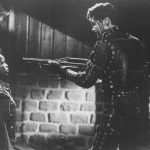If the Old West is America’s mythic past, then the South is its xenotopia, its Orient. Uncle Tom’s Cabin, as discussed previously, partakes in both the Oriental and the Gothic. The HBO series Trueblood focuses on the small Louisiana town of Bon Temps in a world in which vampires have “come out of the coffin.” Likewise, it takes part of the Orientalism and the Gothicism stereotypically associated with the South, using the South as a blank screen for fantasies of, among other things, deviant sexuality.
(Caveat: I’ve only seen the first four episodes.)
Someone’s been bumping off human women who sleep with vampires (“fang-bangers”), and the protagonist Mary Sue… sorry, Sookie enlists her neighbor vampire Bill to drive her out to “Fangtasia,” a vampire bar so she can investigate with her telepathic ability.
Sookie is unimpressed by Fangtasia, with its souvenir t-shirts and desperate human wannabes, like a BDSM club that’s been overrun by vanilla tourists. “It’s like somebody opened a vampire bar in Disneyland,” she comments. It isn’t clear what she is comparing it to, if this is the first vampire bar she’s ever seen. Bill peevishly claims, “It gets more authentic as it gets later.” What he means by “authentic” isn’t clear either, as the real vampires act like snotty club kids who’ve read the Cliff notes to Anne Rice.
Earlier, Bill refers to Sookie’s white print dress as making her look like “vampire bait,” so stereotyping works both ways.
If “Trueblood” uses vampires as a metaphor for gays and other sexual “others”, fetish fashion is used as a synechdoche for deviant sexuality in general.
For a series that begins with a warning not to believe in vampiric stereotypes, “Trueblood” pretty much runs on stereotypes. Apart from a few spokes people who appear on TV talk shows arguing for equal rights, most vampires live up to every trait their enemies claim. They kill people, they seductive, they’re arrogant, and they have a “vampire agenda.”
This reliance on cliche extends to the human characters, most of whom are either defined by their excessive sexuality or their condemnation of the first group. Sookie’s friend Tara chides Sookie’s dim-witted, pussy-hound brother for being “such a fucking cliche,” ignoring the fact that she’s a classic white-girl’s-sassy-black-female-friend.
At least since Bram Stoker’s Dracula, vampires have stood as a symbol of deviant sexuality, exposed through the mode of . We live in a more explicit age than Stoker did, and we want to see more. Fetish and BDSM is used to depict what was once only hinted at. In a way, Trueblood almost makes the vampire elements redundant.
On a personal note, I’m a little disappointed by Trueblood. Alan Ball’s previous series Six Feet Under was, in many ways, a Gothic story, with the characters struggling with isolation and irrational compulsions and the return of the repressed past. The setting, the slightly grubby outskirts of Los Angeles, is far removed from the usual settings and trappings of the Gothic, but it just proves you don’t need a crumbling castle.
Trueblood has the trappings of the Gothic (a heroine with a special perception of the world, a brooding, mysterious man, sexually deviant people who dress in black, etc.) but there are no particular depths to the characters.
Then again, working on Six Feet Under was probably not a terribly fun experience, so perhaps working on something relatively light and fun is understandable.



